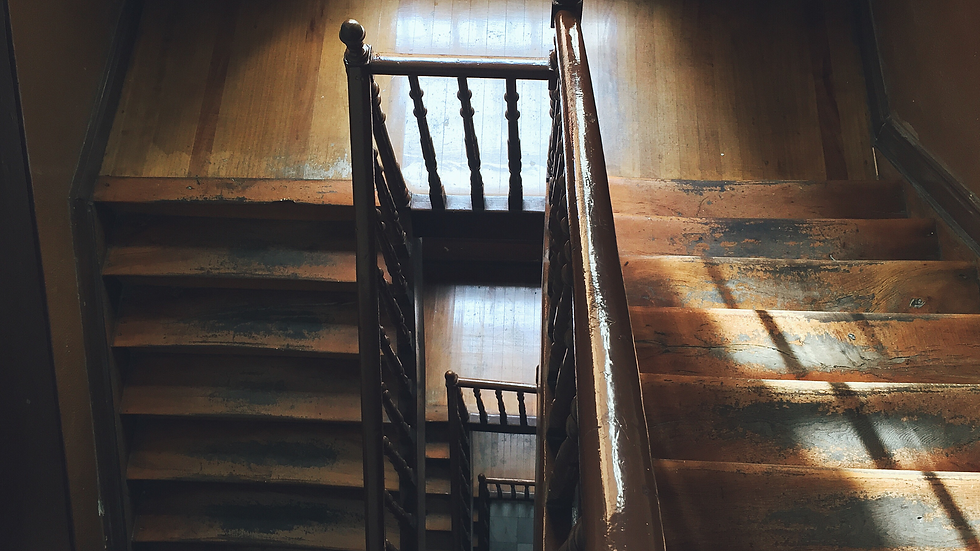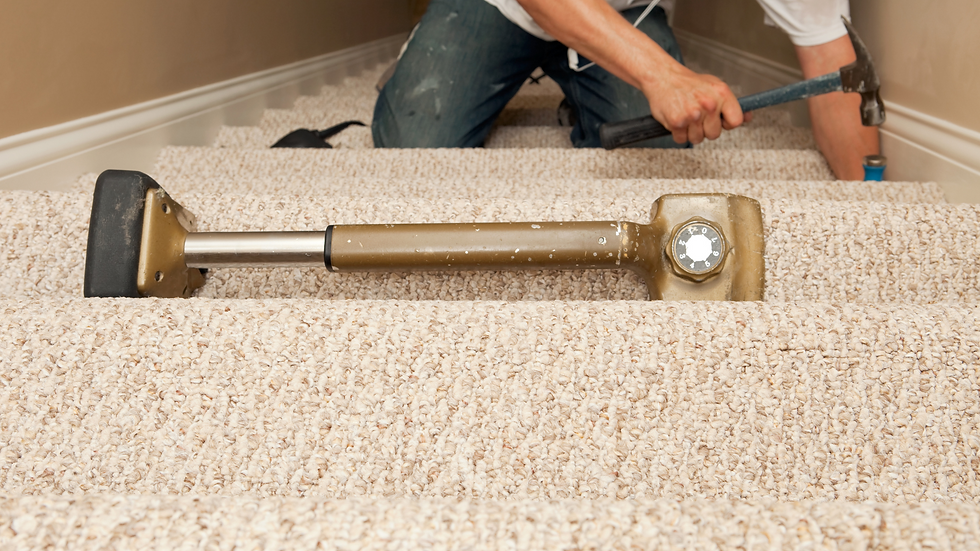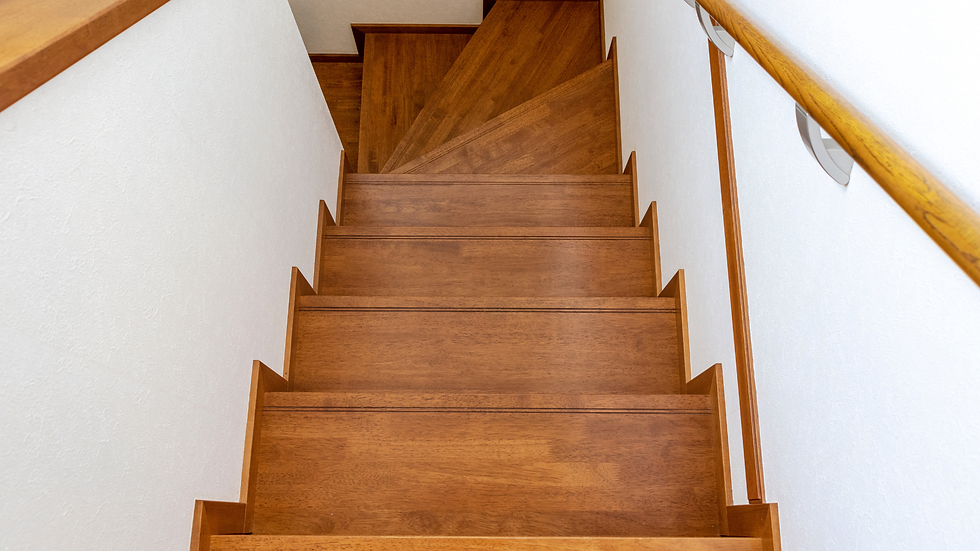How to Detect Hidden Stair Damage Before It’s Too Late
- Up Stairs Rails

- Aug 22
- 5 min read

Your stairs look fine… until one day they don’t. Maybe it’s a faint creak that turns into a wobble, or a hairline crack that suddenly becomes a trip hazard. Hidden stair damage is more common than most homeowners realize, and spotting the signs early can save you from expensive repairs — or worse, a serious safety issue.
Catching these problems before they escalate isn’t just about safety. It’s about protecting your home’s value, keeping your family safe, and avoiding a repair bill that’s a lot bigger than it needs to be. In this guide, we’ll break down the subtle warning signs of damage hiding in plain sight — and what you can do about it.
Why Catching Hidden Stair Damage Early Matters
Hidden stair damage might start small — a faint squeak, a barely-there crack — but it can rapidly become an expensive or dangerous issue. Every year, tens of thousands of injuries happen at home due to falls on stairs alone. According to the National Safety Council, stairway accidents are the second leading cause of unintentional injury in the U.S., right behind car accidents.
Ignoring minor damage isn’t just risky — it can double or even triple your repair costs down the road. What begins as a loose tread might evolve into a wobbly step or a cracked stringer that requires full replacement.
Beyond safety and cost, there's your home’s value. A staircase in poor shape raises red flags for home inspectors and buyers. Fixing issues early—while they’re simple—keeps your home safe, market-ready, and budget-friendly.

Key Signs Your Stairs Are Hiding Damage
Creaks and Squeaks That Don’t Go Away
If your stairs groan every time someone walks up or down, don’t just chalk it up to “old house charm.” Persistent creaks and squeaks can be early signs of stair damage — usually loose treads, nails that have worked their way out, or a bit of settling in the framing underneath. Ignoring it now can lead to bigger (and pricier) issues down the line, like full tread replacements or structural repairs.
Want to be sure your railing isn’t part of the problem? Check out our post on Top 5 Warning Signs Your Stairs Need Immediate Repair.
Cracks, Gaps, and Hairline Fractures
Noticing a hairline crack along a tread or a small gap where the railing meets the wall? These are more than cosmetic issues — they can be early indicators of structural wear or settling. Over time, those tiny imperfections can lead to bigger safety problems, especially if the wood is under stress or starting to rot. According to the International Association of Certified Home Inspectors, visible cracks often mean it’s time for a closer inspection to prevent a minor repair from becoming a major overhaul.
Loose or Wobbly Railings
If your railing moves — even slightly — when you grab it, that’s a red flag. Loose railings aren’t just annoying; they’re a real safety hazard, particularly for kids, elderly family members, or anyone carrying heavy loads up and down the stairs. Stability issues can stem from loose hardware, weakening fasteners, or hidden damage in the posts or framing. The sooner you tighten things up or call in a pro, the safer your staircase will be.
Uneven or Sloping Steps
When a step feels “off,” don’t ignore it. Uneven or sloping treads often point to water damage, settling issues, or even a foundation problem. Aside from the tripping hazard, these shifts can quickly escalate into bigger structural concerns. If you notice a step that feels spongy or out of level, it’s time for an inspection to determine whether it’s a simple fix or a more serious repair.
Water Stains, Soft Spots, or Musty Smells
Moisture is one of the fastest ways to destroy a staircase. Water stains, spongy wood, or even a faint musty smell can all point to moisture intrusion, rot, or mold. Left unchecked, these issues compromise both safety and air quality inside your home. For wood stairs, knowing when to step in can save you from a full replacement later — check out our Ultimate Guide to Wooden Stair Repair for more tips on tackling water-related damage early.
How Often Should You Inspect Your Stairs?
For most homeowners, a quick lookover a couple of times a year is plenty. Stairs don’t fall apart overnight — damage builds slowly — but catching problems early keeps you from facing bigger (and pricier) repairs later.
Think of it like this:
Spring or fall walk-throughs work well. As you clean or prep for a new season, walk your stairs, listen for unusual noises, and check for wobbles, cracks, or water spots.
Professional check every few years. If your home is older, your stairs see heavy daily traffic, or you’ve noticed something off, it’s worth having a pro take a closer look.
Regular attention doesn’t just protect your family’s safety — it helps your stairs last longer and keeps your home’s value intact.
DIY Checks vs. Calling a Pro
When it comes to stair repair, the line between a quick DIY fix and a “call the contractor now” moment isn’t always obvious. Here’s the truth: small issues left alone often turn into expensive problems.
If you’re handy, there are a few things you can safely tackle:
Tightening a loose railing screw or two.
Cleaning and resealing wood once a year to keep moisture out.
Replacing a chipped tread or reattaching loose trim with basic tools.
But if you notice anything that feels structural, it’s time to pick up the phone. Call a pro if:
The squeaks are getting louder or more frequent.
A step feels soft, spongy, or “gives” when you walk on it.
Railings or posts have any movement — even a little wobble can signal deeper issues.
You spot water stains, damp wood, or mold growth.
Not sure which camp your stairs fall into? Pay attention to the signs — if a tread feels spongy, a railing wobbles, or cracks keep growing, it’s time to bring in a pro before a small repair turns into a much bigger problem.
Quick Takeaways
If you skim nothing else, remember this: stairs rarely fail without warning. Keeping an eye (and ear) out for the small stuff helps you avoid major repairs down the line.
Here’s your at-a-glance checklist:
Listen for new noises — squeaks and creaks are often your first red flag.
Look for cracks, gaps, or shifting joints in the steps or railing.
Test your railings; they should feel sturdy and unmoving.
Watch for moisture stains or soft spots, which usually mean water is sneaking in somewhere.
A little attention now saves you money, hassle, and — most importantly — keeps everyone in your home safe.

Take a moment to really look at your stairs. Are the railings steady when you grab them? Do the steps feel solid underfoot, or do you catch the occasional wobble, squeak, or soft spot? These details are easy to ignore, but they’re often the quiet warning signs of bigger problems hiding beneath the surface.
The truth is, hidden stair damage rarely stays hidden for long. Small cracks can grow, moisture can compromise the structure, and those “minor” noises you’ve been tuning out can turn into safety hazards — especially if kids, older adults, or frequent guests are in the home. Catching these problems early not only keeps everyone safe but also saves you money and protects your home’s value.
Your stairs do more than connect one floor to another — they’re part of the backbone of your home. Keeping them solid and secure is one of the simplest ways to protect your investment and your peace of mind.
If you’re starting to notice signs of wear or just want a professional set of eyes on things, Up Stairs Rails offers expert New Jersey stair repair that keeps your home safe, sturdy, and looking its best. Schedule a quick, no-obligation assessment today and step into peace of mind.









Comments